Multi-Language PDF
If you are going to publish a multi-language PDF, you can use the layout to:
Control the order languages are arranged in your multi-language PDF, see Set Language Order (PDF).
To avoid the repetition of the title and subtitle for all included languages on the front cover, you can set the layout to limit it to the first language in the language order, see Display Single Language Titles (PDF).
Add a language list to the front cover, see Set Up a Language List (PDF)
Add language tabs to make it easier to navigate between the language sections of the document, Set Up Language Tabs (PDF).
Include or Exclude Missing Translations (PDF) - If you see red text with a pale pink background in your PDF output, it may be due to the Hide missing translations setting in the PDF layout. If you have it disabled, Paligo will insert the source language content in place of any missing translations. The source language content is red with a pale red background and has the ISO language code in square brackets as a prefix.
Highlight Unapproved Translations (PDF) - If you see blue text in your PDF output, it may be because you have the color mark non-approved translations setting enabled in your PDF layout. This feature sets Paligo to use blue text for translated content that has not been approved.
Tip
If you need to activate and enable languages in your Paligo instance, see Language Management.
When publishing a multi-language PDF the front cover will by default repeat the title and subtitle for all included languages. You can set the layout to limit it to the first language in the language order.
For example, if you publish a multi-language PDF with English and German, the title and subtitle will show on the front cover in both languages.
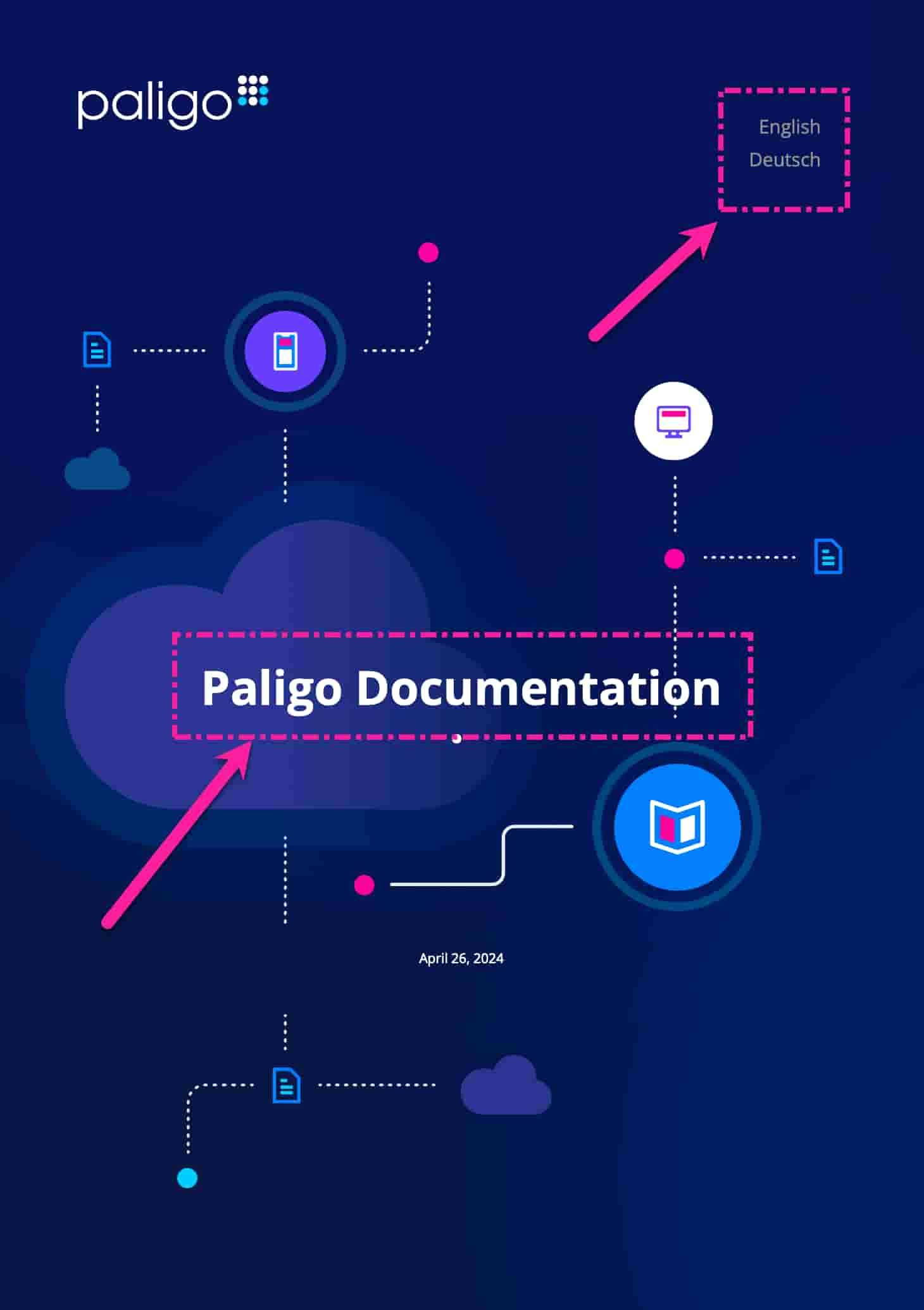 |
This PDF includes two languages, but the publication title is limited to only show one language. No subtitle is used.
Tip
To adjust the language order, see Set Language Order (PDF).
To adjust how your PDF layout display titles and subtitles on the front cover:
Select Layout in the top menu.

Paligo displays a list of Layouts. The list is empty if there are no custom Layouts in your Paligo instance.
Select the Layout you want to update or Create a Layout.
Tip
You can copy the URL of the Layout Editor and paste it into a new tab in your browser. This can be useful if you frequently switch between your Paligo content and the Layout settings.
Select Front page in the sidebar.

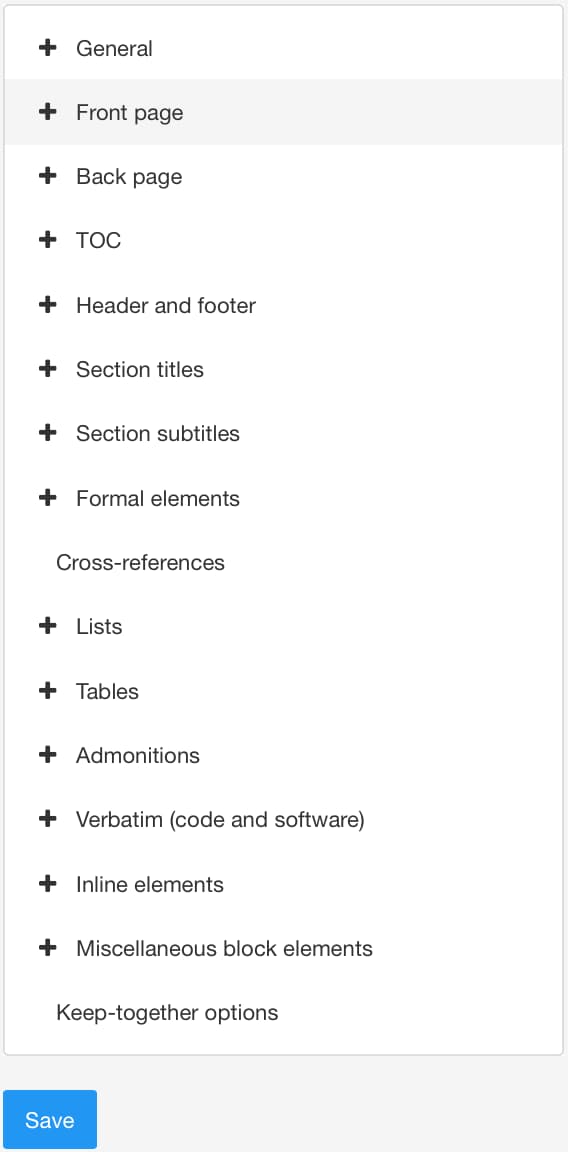
Select Title.
Set Display a single language title to:
Enabled - The front cover will only show the publication name translated to the first language in the language order, see Set Language Order (PDF). The title is the name of the publication in the Publication Topic.
Disabled - The front cover will show multiple titles (one for each language).
Default to inherit the value for this setting from the base Layout. The base Layout is either a built-in Layout provided by Paligo or another custom Layout, see Layout Relationships - Base, New, Duplicate.

Select Subtitle.
Set Display a single language subtitle to:
Enabled - The front cover will only show the subtitle translated to the first language in the language order, see Set Language Order (PDF). This is only used if a
subtitlehas been added to the Publication Topic.Disabled - Sets the PDF to have multiple subtitles on the front cover (one for each language).
Default to inherit the value for this setting from the base Layout. The base Layout is either a built-in Layout provided by Paligo or another custom Layout, see Layout Relationships - Base, New, Duplicate.
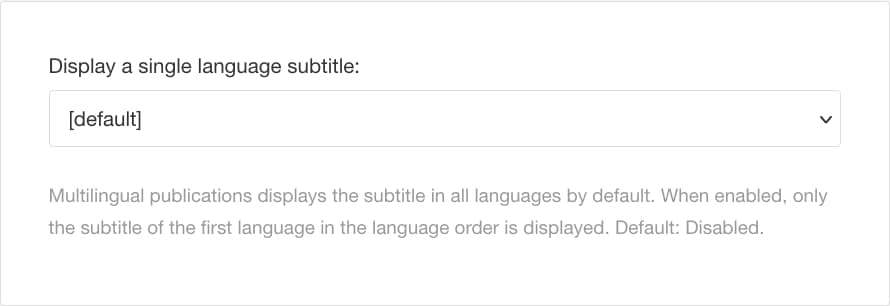
Select Save.
When you publish a multi-language document using this layout, the resulting PDF will use the title and subtitle settings you have chosen.
If you are to publish a multi-language PDF, it can be a good idea to set up a sidebar with language tabs. The language tabs appear at the side edge of the page and show the name of the language used in that part of the PDF. This makes it easier for the user to find the part of the document that is in their language.
The Language local name and Language name in English are set when you Activate Languages or Create Additional Languages.
For example, let's say you have a multi-language PDF for English, German, French and Italian. When you publish, the English pages will have a tab marked "English", the German pages will have a tab marked "Deutsch" and so on.
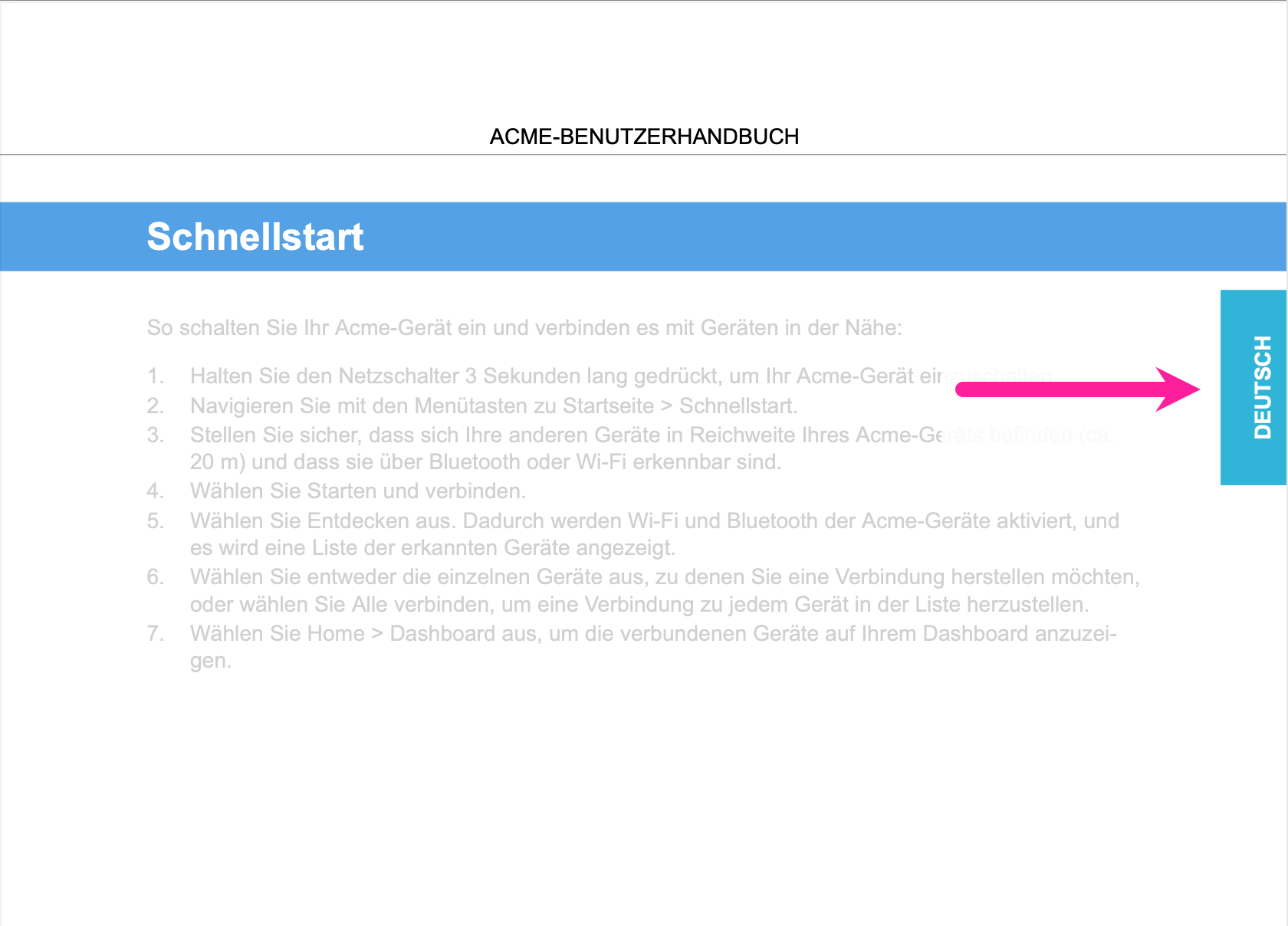 |
In this image, the language tabs are set to show the language local name in Uppercase.
Note
By default, the language tabs reuse the Language List settings until you select another option than Default. Then the setting becomes unique for the language tabs.
However, two of the language list options for the Language name format cannot be applied to language tabs:
Language name in English - local name
Language local name - name in English
If any of these two options is selected as the Language name format for language lists, it will automatically be converted to Language local name for the language tabs. This is because these options become too big for the language tabs.
Tip
By default Paligo uses the two-letter ISO language codes. If you want to use a four-letter code, see Create Additional Languages.
To set up your language tabs:
Select Layout in the top menu.

Paligo displays a list of Layouts. The list is empty if there are no custom Layouts in your Paligo instance.
Select the Layout you want to update or Create a Layout.
Tip
You can copy the URL of the Layout Editor and paste it into a new tab in your browser. This can be useful if you frequently switch between your Paligo content and the Layout settings.
Select General in the sidebar.

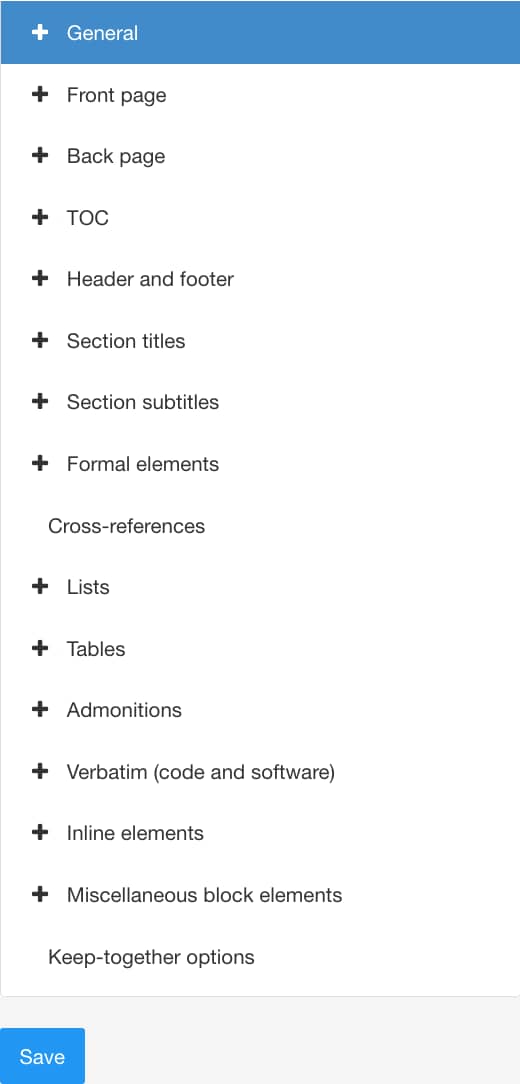
Select Languages.
Use the Display language tabs setting to turn the feature on or off. Choose between:
Enabled to add language tabs on the reverse side of pages (verso side).
Disabled to remove the language tabs from the reverse side of pages.
Default to inherit the value for this setting from the base Layout. The base Layout is either a built-in Layout provided by Paligo or another custom Layout, see Layout Relationships - Base, New, Duplicate.

Note
For a double-sided PDF, you may need to add the language tabs to the reverse side of the pages, see step 6.
Use the Display language tabs on verso pages to control if the tabs are shown on verso pages, when double-sided. Choose between:
Enabled to add language tabs on the reverse side of pages (verso side).
Disabled to remove the language tabs from the reverse side of pages.
Default to inherit the value for this setting from the base Layout. The base Layout is either a built-in Layout provided by Paligo or another custom Layout, see Layout Relationships - Base, New, Duplicate.
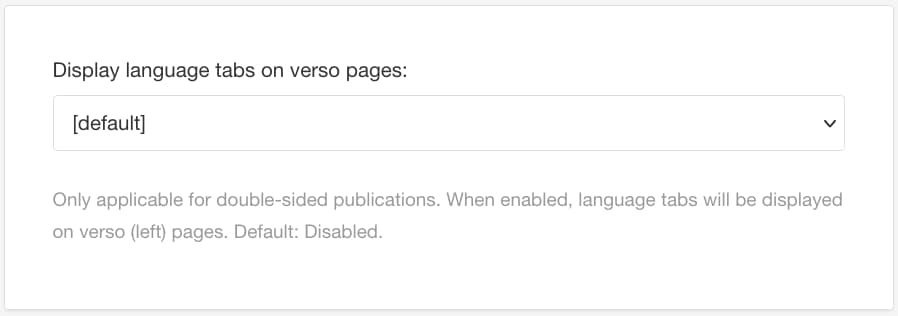
Set the Language name format to control the way the language is displayed.
Language code according to the ISO language codes.
Language local name uses the native name of the language. For example, Deutsch for German and Svenska for Swedish.
Language name in English is the English name of the language.
Default to inherit the value from the Language List setting.
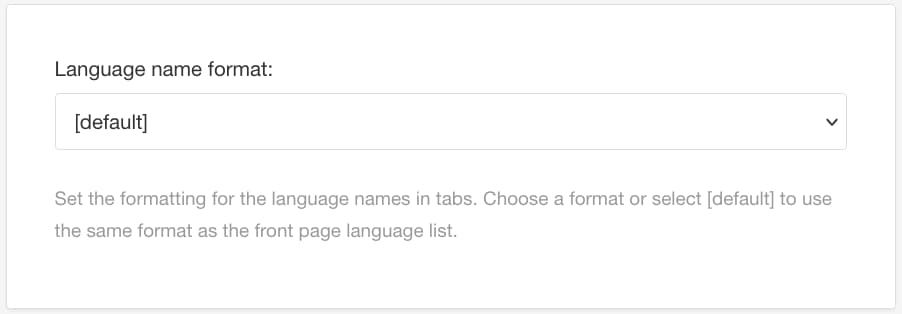
Set the Letter case for language name in tabs. You can choose from:
Upper case - The language name is shown in capital letters in the language tabs (for example DEUTSCH).
Lower case - The language name is shown in lower case letters in the language tabs (for example deutsch).
Capitalize - The first letter of the language name is shown in capital letter and the other letters are shown in lower case (for example Deutsch).
Default to inherit the value from the Language List setting.
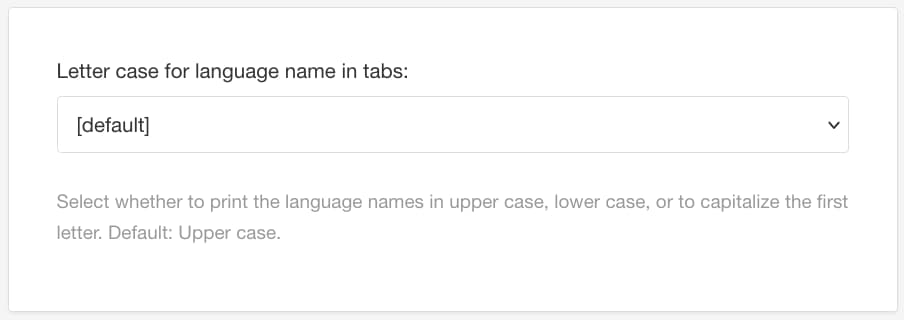
Use the Distance from the top of the topmost language tab to the top of the page setting to control the topmost vertical position. Enter the amount in inches and do not include the units of measurement, for example, 1.85.

Set the Height of a language tab amount to define the vertical size of the language sidebar. Enter the amount in inches and do not include the units of measurement.

Set the Gap between language tabs in inches.

For example, if you set the gap to 1 inch for a multi-language PDF with German, English, Spanish and French:
The German tab appears at the topmost position.
The English tab appears 1 inch lower than the German tab.
The Spanish tab appears 1 inch lower than the English tab.
The French tab appears 1 inch lower than the Spanish tab.
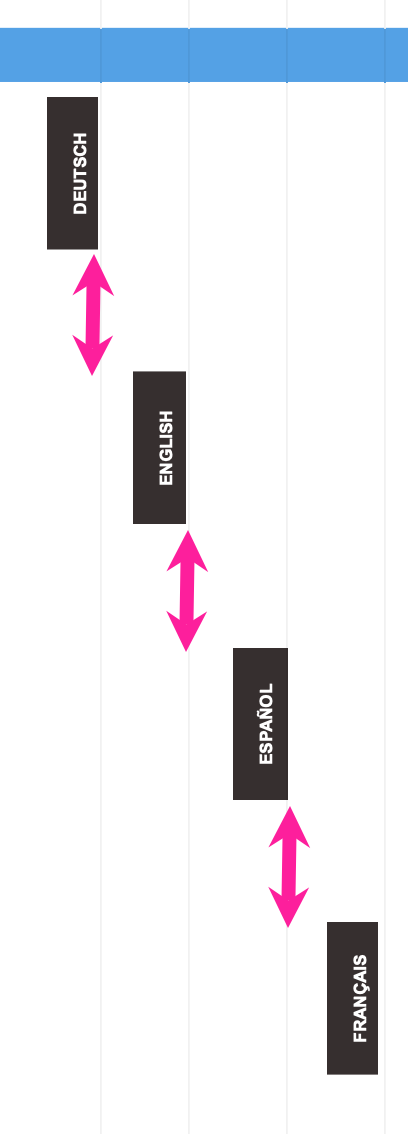
In a printed version of the content, this "cascading" effect makes it easier for users to find the language they need.
Use the Width of a language tab setting to define the horizontal size of the language tabs. Enter an amount in inches, for example, 0.45. Do not enter the units of measurement.

Use the Rounded corners for language tabs: radius setting to control the inner corners of the language sidebar. By default, the inner corners are straight-edged but you can set them to be rounded instead.

To use rounded corners, enter an amount and include the units of measurement, for example, 10pt.
To disable rounded corners, clear the field so that it uses the default of 0pt.

Use the Background color for language tabs to control the color of the tab. The default color is black.
The text in the language tab is white, so choose a darker background color to get a suitable amount of contrast.

Clear the Use default color checkbox to select a color of your own choice.
Set the color either by:
Entering an RGBA code for the color you want (1).
Selecting the Color square to display the color selector (2).
Choose the color with the spectrum bar (3).
Control the transparency with the opacity bar (4).
Choose the color shade with the main color panel (5).
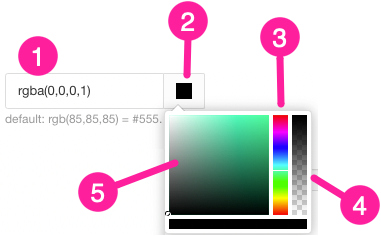
Select Save.
When you publish multi-language content with this PDF layout, the resulting PDF will use the language sidebar settings you have chosen.
Use the layout setting Language order to control how the languages are arranged in your multi-language PDF. It determines:
The way the publication title and subtitle translations are arranged on the front cover. By default, all translations are shown. However, you can set the layout to limit it to the first language in the language order, see Display Single Language Titles (PDF).
The way the language list is arranged on the front cover (top-right corner).
The way the translated content appears in the multi-language PDF.
 |
This PDF includes two languages, but the publication title is limited to only show one language. No subtitle is used.
To set the language order for your multi-language PDF:
Select Layout in the top menu.

Paligo displays a list of Layouts. The list is empty if there are no custom Layouts in your Paligo instance.
Select the Layout you want to update or Create a Layout.
Tip
You can copy the URL of the Layout Editor and paste it into a new tab in your browser. This can be useful if you frequently switch between your Paligo content and the Layout settings.
Select General in the sidebar.


Select Languages.
Define the Language order by entering the two-letter ISO language code for each language. Use spaces to separate the languages.
For example: de en es fr will result in German first, English second, Spanish third and French fourth.
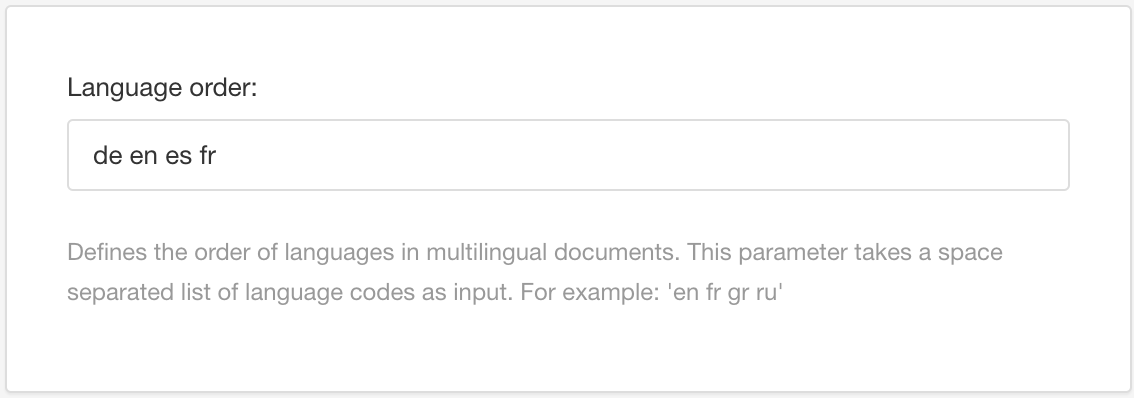
Select Save.
When you publish a combined language output with this layout, the resulting PDF will have the languages in the order you specified.